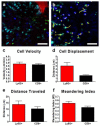Tracking Cell Recruitment and Behavior within the Tumor Microenvironment Using Advanced Intravital Imaging Approaches
- PMID: 29970845
- PMCID: PMC6071013
- DOI: 10.3390/cells7070069
Tracking Cell Recruitment and Behavior within the Tumor Microenvironment Using Advanced Intravital Imaging Approaches
Abstract
Recent advances in imaging technology have made it possible to track cellular recruitment and behavior within the vasculature of living animals in real-time. Using approaches such as resonant scanning confocal and multiphoton intravital microscopy (IVM), we are now able to observe cells within the intact tumor microenvironment of a mouse. We are able to follow these cells for extended periods of time (hours) and can characterize how specific cell types (T cells, neutrophils, monocytes) interact with the tumor vasculature and cancer cells. This approach provides greater insight into specific cellular behaviors and cell⁻cell interactions than conventional techniques such as histology and flow cytometry. In this report, we describe the surgical preparation of animals to expose the tumor and both resonant scanning confocal and multiphoton imaging approaches used to track leukocyte recruitment, adhesion, and behavior within the tumor microenvironment. We present techniques for the measurement and quantification of leukocyte behavior within the bloodstream and tumor interstitium. The use of IVM to study leukocyte behavior within the tumor microenvironment provides key information not attainable with other approaches, that will help shape the development of better, more effective anticancer drugs and therapeutic approaches.
Keywords: cancer; imaging; intravital; leukocytes; trafficking; vasculature.
Conflict of interest statement
The authors declare no conflict of interest.
Figures






Similar articles
-
Intravital microscopy in the study of the tumor microenvironment: from bench to human application.Oncotarget. 2018 Apr 13;9(28):20165-20178. doi: 10.18632/oncotarget.24957. eCollection 2018 Apr 13. Oncotarget. 2018. PMID: 29732011 Free PMC article. Review.
-
Video-rate resonant scanning multiphoton microscopy: An emerging technique for intravital imaging of the tumor microenvironment.Intravital. 2012;1(1):10.4161/intv.21557. doi: 10.4161/intv.21557. Intravital. 2012. PMID: 24353926 Free PMC article.
-
Extended Time-lapse Intravital Imaging of Real-time Multicellular Dynamics in the Tumor Microenvironment.J Vis Exp. 2016 Jun 12;(112):54042. doi: 10.3791/54042. J Vis Exp. 2016. PMID: 27341448 Free PMC article.
-
Intravital Microscopy for Imaging the Tumor Microenvironment in Live Mice.Methods Mol Biol. 2016;1458:217-30. doi: 10.1007/978-1-4939-3801-8_16. Methods Mol Biol. 2016. PMID: 27581025
-
Imaging Nanotherapeutics in Inflamed Vasculature by Intravital Microscopy.Theranostics. 2016 Oct 8;6(13):2431-2438. doi: 10.7150/thno.16307. eCollection 2016. Theranostics. 2016. PMID: 27877245 Free PMC article. Review.
Cited by
-
Noninvasive in vivo microscopy of single neutrophils in the mouse brain via NIR-II fluorescent nanomaterials.Nat Protoc. 2024 Aug;19(8):2386-2407. doi: 10.1038/s41596-024-00983-3. Epub 2024 Apr 11. Nat Protoc. 2024. PMID: 38605264 Review.
-
Miniature side-view dual axes confocal endomicroscope for repetitive in vivo imaging.Biomed Opt Express. 2023 Jul 26;14(8):4277-4295. doi: 10.1364/BOE.494210. eCollection 2023 Aug 1. Biomed Opt Express. 2023. PMID: 37799693 Free PMC article.
-
Approaches for neutrophil imaging: an important step in personalized medicine.Bioengineered. 2022 Jun;13(6):14844-14855. doi: 10.1080/21655979.2022.2096303. Bioengineered. 2022. PMID: 36469646 Free PMC article. Review.
-
Volume imaging to interrogate cancer cell-tumor microenvironment interactions in space and time.Front Immunol. 2023 May 16;14:1176594. doi: 10.3389/fimmu.2023.1176594. eCollection 2023. Front Immunol. 2023. PMID: 37261345 Free PMC article. Review.
-
VSV∆M51 drives CD8+ T cell-mediated tumour regression through infection of both cancer and non-cancer cells.Nat Commun. 2024 Nov 15;15(1):9933. doi: 10.1038/s41467-024-54111-6. Nat Commun. 2024. PMID: 39548070 Free PMC article.
References
-
- Cohnheim J. Untersuchungen über die Embolischen Process. August Hirschwald; Berlin, Germany: 1872.
-
- Waller A. Microscopic observations on the perforation of the capillaries by the corpuscles of the blood, and on the origin of mucus and pus-globules. Lond. Edinb. Dublin Philos. Mag. 1846;29:397–405. doi: 10.1080/14786444608645527. - DOI
-
- Hall M. A Critical and Experimental Essay on the Circulation of the Blood. R.B. Seeley and W. Burnside; London, UK: 1831.
LinkOut - more resources
Full Text Sources
Other Literature Sources

